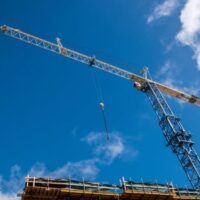Crane Injuries in Construction and Manufacturing

Crane operators are essential for a wide range of construction and manufacturing work on jobsites that require moving heavy loads. While crane safety has improved, and employers have recognized the need to take training for crane operation and work around cranes very seriously, serious accidents and injuries still occur in Maryland and throughout the country. Both crane operators and workers around cranes can be seriously injured or killed in various types of accidents that commonly involve cranes. When crane injuries occur in construction and manufacturing jobs, it is important for injured workers to seek help with a workers’ compensation claim. Our Maryland workers’ compensation attorneys can tell you more.
Getting the Facts About Serious and Deadly Crane Accidents
Between 2011 and 2017, the US Bureau of Labor Statistics reported that there were 297 deaths in crane accidents, and about half of those fatalities involved a worker being struck by an object or the crane equipment. A high rate of crane-related fatalities also involved workers being struck by cranes in transportation accidents.
When worker injuries and fatalities involving cranes occur, almost any type of employee in the construction or manufacturing area can be at risk of injury, including crane operators themselves, as well as workers in various roles on the ground. Some of the most common causes of crane accidents in construction and manufacturing involve the following:
- Crane tip-over accident;
- Failure of crane boom or cable;
- Crane operators falling out of a crane;
- Equipment or materials being moved by the crane striking a worker or falling on a worker;
- Crane backing over a worker; and
- Crane contacting live power lines and causing electrical injuries and electrocutions.
Preventing Crane Accidents in Construction and Manufacturing Jobs
The Occupational Safety and Health Administration (OSHA) identifies crane safety as a critical focus and emphasizes that employers and employees alike should be aware of hazards and solutions to them when it comes to crane accidents. The following are some safety tips for preventing crane accidents on jobsites:
- Use the appropriate crane for the job being done;
- Ensure that crane operators and workers are properly trained to safely operate and/or work around a crane;
- Routinely check the crane for maintenance issues;
- Clear the pathway the crane will be using; and
- Only load what the crane can hold based on the crane’s load limits and load correctly.
Even when a crane accident results from an employer’s failure to adhere to a safety guideline, or an employee’s own negligence, workers’ compensation is usually the “exclusive remedy.” In other words, it is not possible to file a lawsuit based on negligence — it is only possible to obtain compensation through the workers’ compensation system. However, if the crane accident resulted from a third party’s negligence, from an employer’s intentional act designed to cause harm, or from a crane or other product defect, it may be possible to file a lawsuit in addition to seeking workers’ compensation benefits.
Contact a Maryland Construction Worker Injury Attorney
If you or a loved one got hurt in a crane accident at work, it is essential to seek legal advice about obtaining workers’ compensation benefits. Contact one of the experienced Maryland construction worker injury lawyers at the Law Offices of Steinhardt, Siskind and Lieberman, LLC today to discuss your case and to learn more about your options.
Sources:
bls.gov/iif/factsheets/fatal-occupational-injuries-cranes-2011-17.htm
osha.gov/cranes-derricks/
